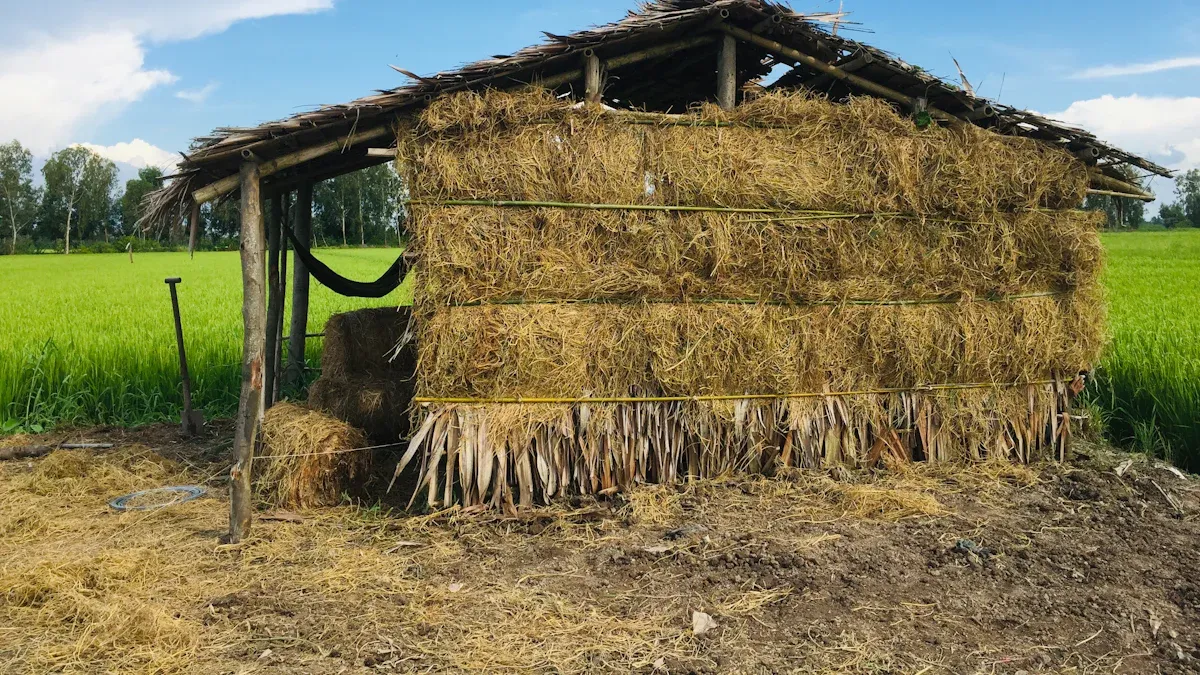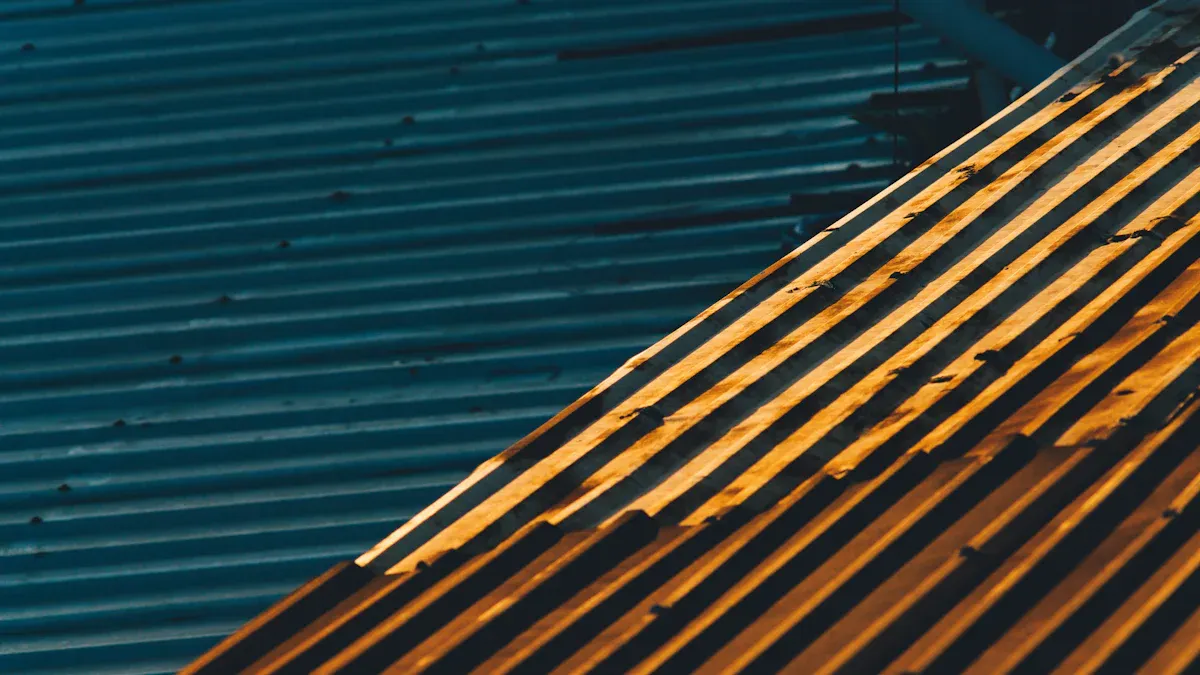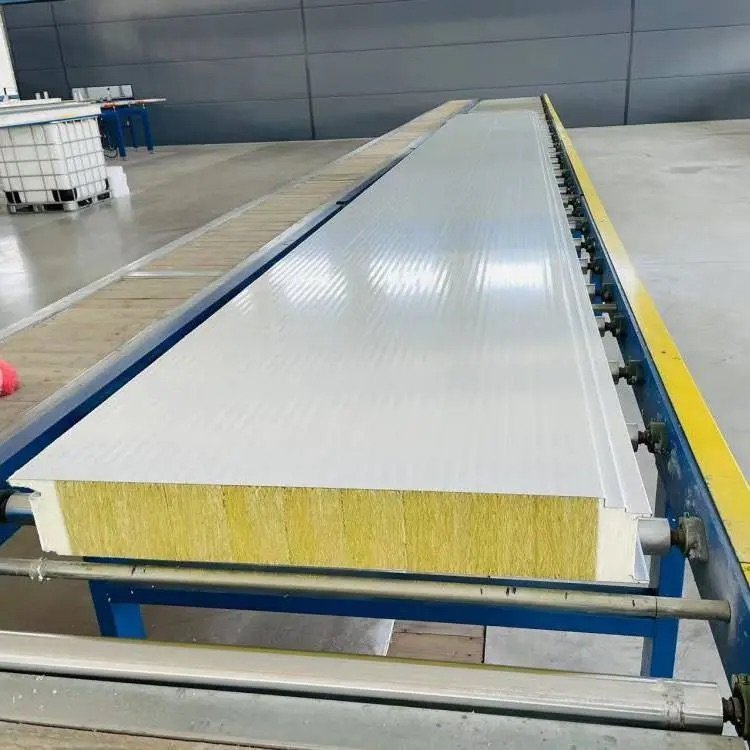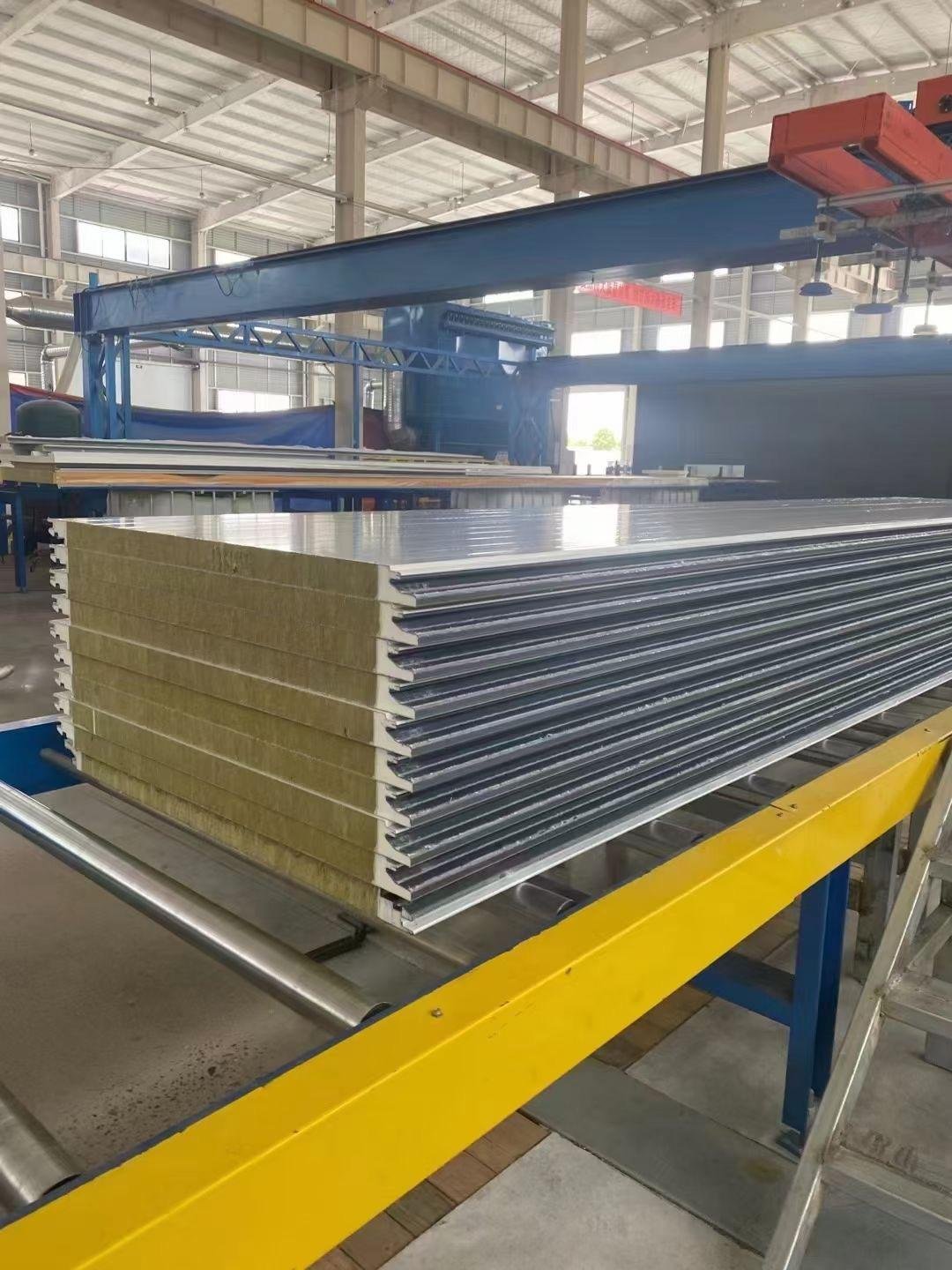
Agricultural buildings have special problems like temperature changes and moisture. They also need to be strong and long-lasting. Sandwich panels help solve these issues, making them important for modern farm buildings. Their layers keep heat in or out, keeping indoor temperatures steady for animals and plants.
These panels are also very strong. For instance, sandwich panels with wood strand cores are better than regular OSB panels. They bend less and hold more weight. They can cover longer spaces while staying sturdy, which is great for big farm buildings.
Key Takeaways
Sandwich panels keep temperatures steady, saving energy and heating costs.
They are light and simple to use, making building faster and cheaper.
These panels are strong and resist bad weather, lasting a long time.
They stop condensation, preventing mold and rust, keeping spaces healthy.
Using them helps the environment by saving energy and using green materials.
Benefits of Sandwich Panels in Agricultural Buildings
Thermal Insulation
Sandwich panels help keep temperatures steady inside farm buildings. Their layers stop heat from moving in or out. This keeps animals and plants comfortable all year. Unlike concrete or brick, sandwich panels provide better temperature control.
Sandwich panels with staggered shear connections hold heat better, reaching 2.48 m²K/W.
Low-density core panels lose two-thirds less heat than concrete or brick walls.
This great insulation saves energy and supports eco-friendly farming. Using sandwich panels lowers heating and cooling costs while boosting productivity.
Durability and Weather Resistance
Farm buildings face tough weather like rain and wind. Sandwich panels are strong and protect buildings from damage. Their corrugated cores make them perfect for heavy loads and long spaces.
Wood strand corrugated core panels carry 378% more load for short spans and 421% more for long spans than OSB panels.
Wheat straw corrugated core panels hold 262% more for short spans and 334% more for long spans than OSB panels.
These panels last longer and need less fixing, saving money. Their strength makes them a smart choice for farm buildings.
Lightweight and Easy Handling
Sandwich panels are light, making them easy to move and install. Their light weight speeds up building and cuts labor costs. Special lifting tools make the job even faster.
Sandwich panels stay strong with high bending stiffness and bending moment.
Their light design lowers transport costs and speeds up assembly, helping eco-friendly building.
With sandwich panels, you can build strong structures quickly and easily. Their lightweight design is perfect for farm projects where time and efficiency matter.
Cost-effectiveness
Sandwich panels are a budget-friendly choice for farm buildings. Their light weight lowers shipping costs. They are simple to install, saving on labor. Unlike older materials, sandwich panels take less time to put together. This makes building projects cheaper overall.
Panels with corrugated cores are strong but use fewer materials. This cuts waste and makes them eco-friendly. Using natural materials like wheat straw or wood strands saves even more money. These materials are renewable and often cost less than man-made ones.
You also save money in the long run. Sandwich panels last a long time and handle bad weather well. You spend less fixing or maintaining them over the years. Their insulation keeps buildings warm in winter and cool in summer. This lowers heating and cooling bills.
Choosing sandwich panels means getting good value and strong performance. They combine cost savings with durability, making them a great pick for farm buildings.
Prevention of Condensation
Condensation can harm farm buildings by causing mold and rust. It can also ruin stored items. Sandwich panels stop these problems. Their design includes a core that resists moisture, keeping water vapor out.
Corrugated core panels are especially good at this. They allow air to flow better, reducing moisture buildup. Panels made from natural materials like mineral wool or polystyrene also resist soaking up water. This keeps the building dry and safe.
By stopping condensation, sandwich panels protect animals, crops, and tools. They make a healthier space for animals and keep stored goods from spoiling. These panels help keep your farm building in good shape.
Common Uses of Sandwich Panels in Farming
Animal Shelters
Farm animals need safe and comfy places to live. Sandwich panels are great for building shelters because they keep temperatures steady. This helps animals stay healthy in hot or cold weather. These panels also stop moisture, which prevents mold and rust.
They are light and easy to set up, saving time and money. You can use them for roofs or walls to make strong, weatherproof buildings. They work well in different climates, meeting the needs of your farm.
Sandwich panels are often used for animal shelters.
They work as roofing and wall materials in farm buildings.
Their uses go beyond farming, like in sports centers.
Storage Buildings
Good storage keeps crops, tools, and supplies safe. Sandwich panels are great for storage because they keep inside temperatures steady. This protects items from heat, cold, and moisture. They are strong enough to hold heavy goods and block wind and rain.
Their light weight makes them quick to install, cutting labor costs and saving time. They also lower energy bills by keeping the temperature controlled. This makes them a smart and affordable choice for farm storage.
Sandwich panels provide great insulation for storage buildings.
They protect stored items from damage caused by weather.
They save energy, making them cost-effective for farms.
Plant Greenhouses
Greenhouses need materials that control heat and light well. Sandwich panels are perfect for this job. They keep the right temperature for plants and stand up to bad weather.
You can use them for greenhouse walls or roofs. Their light weight makes building easier, so you can focus on growing crops. Using natural materials like farm waste in the panels also supports eco-friendly farming.
Sandwich panels fit many building needs, including greenhouses.
They help sustainable farming by using renewable materials like farm waste.
Their insulation and strength make them great for greenhouses.
Machinery and Equipment Sheds
Machinery sheds protect tools and machines on farms. Sandwich panels are great for building these sheds. They are light, so they are easy to move. Pre-made panels make building faster and simpler. This saves time and lowers labor costs.
These panels are strong and handle bad weather well. They protect equipment from rain, wind, and other harsh conditions. Their insulation keeps the shed’s temperature steady. This stops machines from getting damaged by heat or cold.
Sandwich panels also help the environment. Panels made from farm waste, like straw or husks, are eco-friendly. Choosing these materials supports renewable farming while building a strong shed.
Benefits of sandwich panels for machinery sheds:
Quick to install.
Pre-made panels save time.
Barns and Freezers
Barns and freezers are important for farming. Sandwich panels work well for these buildings. They keep barns warm and freezers cold, protecting animals and food.
These panels are tough and last a long time. They are perfect for farms with rough weather. Using materials like straw or husks makes them eco-friendly. This reduces waste and supports green farming.
With sandwich panels, barns and freezers are cheaper and energy-saving. They also stop moisture, keeping buildings in good shape for years.
Types of Sandwich Panel Materials
Picking the right sandwich panel material is very important. Different materials have unique benefits for farm buildings. Below are three common types and their advantages.
Metal-faced Panels
Metal-faced panels are often used in farm buildings. They are light but very strong, making them last long. These panels also keep indoor temperatures steady, saving energy.
Metal-faced panels are strong and lightweight for long use.
Their pre-made design makes building faster and cheaper.
They stand up to bad weather, keeping buildings safe.
These panels work well for barns, sheds, and storage spaces. They can hold heavy loads and handle tough weather.
Polyurethane Core Panels
Polyurethane panels are great for keeping temperatures steady. This is important for animal shelters and freezers. They are light and easy to install, saving time and money.
Their special design makes them strong and eco-friendly. They use fewer materials, which helps the environment. Panels made from natural items like straw or husks are also a green choice.
Mineral Wool Core Panels
Mineral wool panels are good for fire safety, soundproofing, and insulation. These features make them great for safe and comfy farm buildings.
Benefit | What It Does |
|---|---|
Fire Safety | Mineral wool does not burn, keeping buildings safe. |
Noise Reduction | These panels block noise, making quieter spaces. |
Temperature Control | Good insulation saves energy by cutting heating and cooling costs. |
Mineral wool panels also make buildings stronger. They are perfect for barns, freezers, and other places needing tough materials.
Expanded Polystyrene (EPS) Core Panels
EPS panels are great for keeping farm buildings warm or cool. They help protect animals, crops, and tools by keeping temperatures steady. These panels are light, so they are easy to carry and set up. You can pick different sizes and thicknesses to match your needs.
EPS panels are also good for the environment. They can be recycled, so you can reuse them and cut down on waste. They cost less than older building materials, saving you money while still being strong and reliable.
Here’s a simple look at what makes EPS panels special:
Feature | What It Means |
|---|---|
Insulation Strength | EPS keeps heat in or out, perfect for farm use. |
Lightweight | Easy to move and install because it’s not heavy. |
Flexible Options | Comes in many sizes and thicknesses for different jobs. |
Eco-Friendly | Can be recycled, helping reduce waste on farms. |
Budget-Friendly | Costs less than older materials but works just as well. |
Using EPS panels helps you build strong, energy-saving farm buildings. They lower heating and cooling costs, making them a smart choice. Whether for storage, animal shelters, or greenhouses, EPS panels are a dependable and eco-friendly option.
Fiberglass Sandwich Panels
Fiberglass panels are another good pick for farm buildings. They are strong but light, so they can handle bad weather like heavy rain or wind.
These panels don’t rust or soak up water, making them great for wet places like barns or greenhouses. They also keep indoor temperatures steady, which is good for plants and animals.
Fiberglass panels are quick to install, saving time and work. Their smooth surface is easy to clean, keeping spaces safe and healthy for animals or food. They last a long time, so you won’t need to fix or replace them often.
If you want something strong, easy to clean, and good at keeping temperatures steady, fiberglass panels are a smart choice. They work well for many farm uses, like tool sheds or freezers.
Installation Process for Sandwich Panels
Preparation and Planning
Good planning makes installing sandwich panels easier. Start by making a clear plan for where each panel will go. Include a schedule and list of needed tools to avoid delays. Gather all materials before starting to save time.
Tip: Check the first panel’s position carefully. If it’s not straight, the rest might not fit well.
Use this table to help with planning:
Aspect | Description |
|---|---|
Place the first panel carefully. Make sure it fits tightly. | |
Preparatory Steps | Plan panel placement and finish all paperwork before starting. |
Adhering to Procedures | Follow steps in order. Finish prep work before assembly. |
By planning well, you can avoid mistakes and make sure the panels work properly.
Panel Assembly
Putting sandwich panels together needs care and focus. Start by shaping and building the main parts, like metal sheets and frames. These parts hold the panels in place. Add mechanical and electrical systems next, making sure they fit and work correctly.
Here’s a table of key parts:
Description | |
|---|---|
Sheet metal fabrication | Shape and join metal sheets for strong support. |
Skid frame fabrication | Build frames to hold equipment in place. |
Mechanical assembly | Put together moving parts and systems. |
Electrical panels | Set up control panels for power and operation. |
Instrumentation | Install tools to monitor and control systems. |
Testing and commissioning | Test everything to make sure it works as planned. |
Make sure joints are tight and sealed well. This stops air leaks and keeps the panels insulated.
Finishing Touches
The last step is to improve the structure’s look and strength. Cover exposed parts with protective coatings to stop rust and weather damage. Check all seals and joints to make sure they are secure and waterproof.
Note: Clean the panels after installing them. This removes dirt and makes them look neat.
Test the building before using it. Check if it controls temperature, resists moisture, and stays stable. These final steps help the sandwich panels last longer and work better.
Cost Considerations for Sandwich Panels
Initial Investment
At first, sandwich panels might seem expensive. They use high-quality cores like polyurethane (PU) or polyisocyanurate (PIR). These cores are paired with strong steel or aluminum layers. This makes them very sturdy but raises the price. Also, installing them needs special tools and skilled workers, which adds to the cost.
Compared to wood or concrete, sandwich panels cost more upfront. But this higher price reflects their better quality and strength. While the initial cost may feel high, it leads to long-term benefits that make it worth it.
Long-term Savings
Even though sandwich panels cost more at first, they save money later. Their great insulation lowers heating and cooling costs. This is very helpful for barns or freezers that need steady temperatures. By keeping the inside climate stable, these panels use less energy and cut utility bills.
They are also very durable, so you spend less on repairs. Unlike wood or concrete, sandwich panels resist bad weather, water, and pests. This means fewer replacements and less maintenance, saving money every year.
Value for Money
Sandwich panels give great value for their cost. They are light, so building is faster and needs less labor. Even though they are lightweight, they are strong and reliable for farm buildings.
These panels are also eco-friendly. Many are made from recyclable or renewable materials, which support green farming. Choosing sandwich panels means you get durability, performance, and environmental benefits all in one.
Tip: Think of sandwich panels as a smart investment. They cost more upfront, but the savings and benefits make them worth it for your farm.
Sandwich panels are a smart choice for farm buildings. They keep heat in or out, saving energy and cutting costs. These panels are light, so they’re easy to move and install. They are strong and can handle tough weather, lasting a long time. Plus, they use recyclable materials, which helps the environment.
Use sandwich panels to build strong and energy-saving farm structures. They work well for barns, greenhouses, and storage spaces. These panels make farming easier and more eco-friendly. Try them to improve your farm and support sustainable practices.
FAQ
Why are sandwich panels good for the environment?
Sandwich panels use materials that can be recycled or renewed. This helps cut down on waste. They also save energy by keeping buildings warm or cool. Choosing these panels helps protect the planet and supports green farming.
Can sandwich panels take the place of older building materials?
Yes, sandwich panels can replace wood or concrete. They are strong, light, and keep temperatures steady. These features make them a great choice for farm buildings.
Do sandwich panels work in all types of weather?
Yes, sandwich panels handle different weather well. They block moisture, heat, and cold, staying strong and comfy. This makes them useful for farms in any climate.
How do sandwich panels help save money?
Sandwich panels lower heating and cooling costs with their insulation. Their light weight makes building faster and cheaper. They last a long time, so you spend less on repairs.
Why are sandwich panels a smart pick for eco-friendly farming?
Sandwich panels use green materials and save energy. They last for years and can be recycled. This makes them perfect for farmers who care about the environment.







